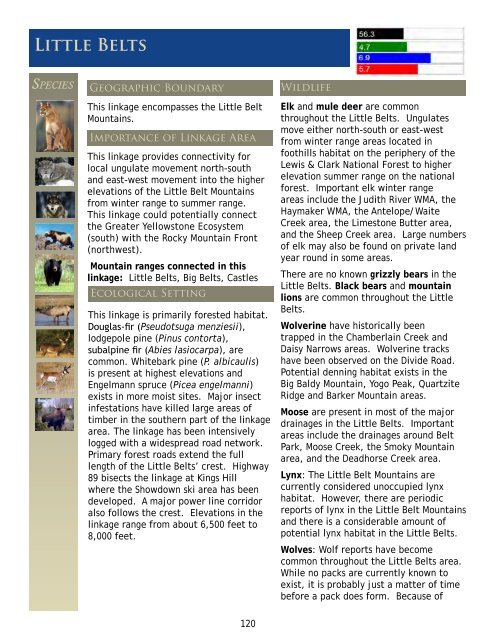The Hub Conservation Area - Montanans 4 Safe Wildlife Passage
The Hub Conservation Area - Montanans 4 Safe Wildlife Passage
The Hub Conservation Area - Montanans 4 Safe Wildlife Passage
You also want an ePaper? Increase the reach of your titles
YUMPU automatically turns print PDFs into web optimized ePapers that Google loves.
Little BeltsSpeciesGeographic BoundaryThis linkage encompasses the Little BeltMountains.Importance of Linkage <strong>Area</strong>This linkage provides connectivity forlocal ungulate movement north-southand east-west movement into the higherelevations of the Little Belt Mountainsfrom winter range to summer range.This linkage could potentially connectthe Greater Yellowstone Ecosystem(south) with the Rocky Mountain Front(northwest).Mountain ranges connected in thislinkage: Little Belts, Big Belts, CastlesEcological SettingThis linkage is primarily forested habitat.Douglas-fir (Pseudotsuga menziesii),lodgepole pine (Pinus contorta),subalpine fir (Abies lasiocarpa), arecommon. Whitebark pine (P. albicaulis)is present at highest elevations andEngelmann spruce (Picea engelmanni)exists in more moist sites. Major insectinfestations have killed large areas oftimber in the southern part of the linkagearea. <strong>The</strong> linkage has been intensivelylogged with a widespread road network.Primary forest roads extend the fulllength of the Little Belts’ crest. Highway89 bisects the linkage at Kings Hillwhere the Showdown ski area has beendeveloped. A major power line corridoralso follows the crest. Elevations in thelinkage range from about 6,500 feet to8,000 feet.<strong>Wildlife</strong>Elk and mule deer are commonthroughout the Little Belts. Ungulatesmove either north-south or east-westfrom winter range areas located infoothills habitat on the periphery of theLewis & Clark National Forest to higherelevation summer range on the nationalforest. Important elk winter rangeareas include the Judith River WMA, theHaymaker WMA, the Antelope/WaiteCreek area, the Limestone Butter area,and the Sheep Creek area. Large numbersof elk may also be found on private landyear round in some areas.<strong>The</strong>re are no known grizzly bears in theLittle Belts. Black bears and mountainlions are common throughout the LittleBelts.Wolverine have historically beentrapped in the Chamberlain Creek andDaisy Narrows areas. Wolverine trackshave been observed on the Divide Road.Potential denning habitat exists in theBig Baldy Mountain, Yogo Peak, QuartziteRidge and Barker Mountain areas.Moose are present in most of the majordrainages in the Little Belts. Importantareas include the drainages around BeltPark, Moose Creek, the Smoky Mountainarea, and the Deadhorse Creek area.Lynx: <strong>The</strong> Little Belt Mountains arecurrently considered unoccupied lynxhabitat. However, there are periodicreports of lynx in the Little Belt Mountainsand there is a considerable amount ofpotential lynx habitat in the Little Belts.Wolves: Wolf reports have becomecommon throughout the Little Belts area.While no packs are currently known toexist, it is probably just a matter of timebefore a pack does form. Because of120




